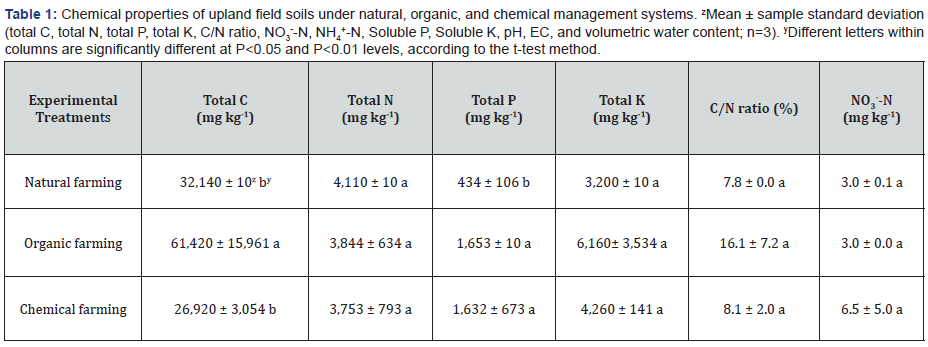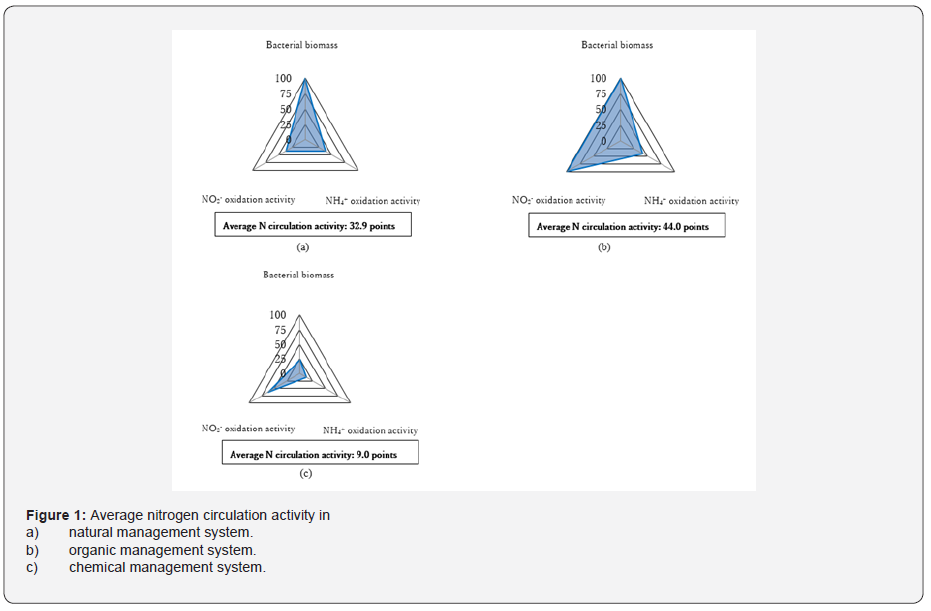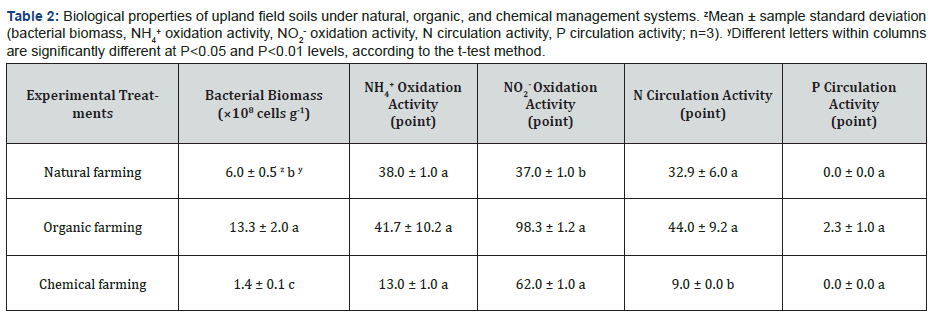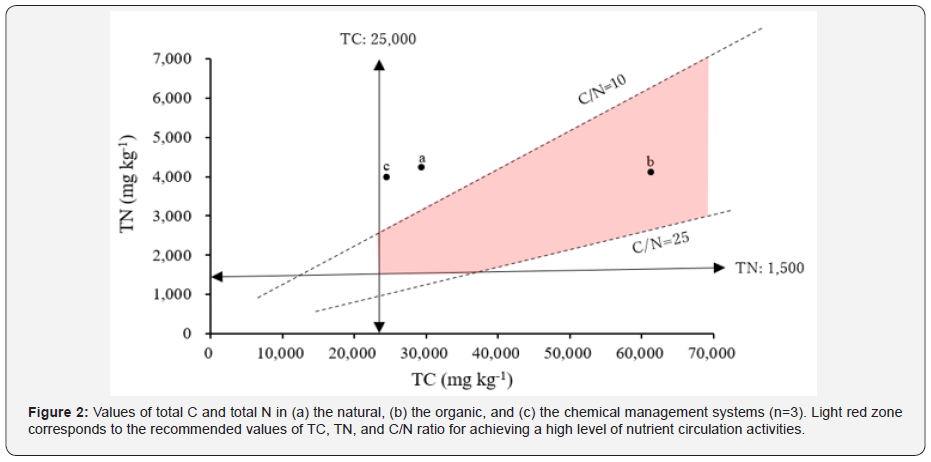Juniper Publishers - Influence of Natural, Organic and Chemical Management Systems on Biochemical Properties of Upland Agricultural Fields with Special Reference to Nutrient Cycling Activities
Trends in Technical & Scientific Research
Abstract
Field crop cultivation in Japan typically involves the use of chemical fertilizers and pesticides which can damage the environment. In this study, we investigated soil biochemical properties of the upland fields grown naturally (no tillage, no fertilizer, no pesticide), organically (organic fertilizers, no synthetic pesticides), and with conventional chemical fertilizers and pesticides. The organically managed system soil had significantly greater total carbon and soil bacterial biomass than the other two soils. Also, nitrogen circulation activity was significantly greater in the natural and organic management system soils than in the chemically fertilized soil. These results indicate that environmentally friendly soil management practices in upland fields, such as cultivation with organic fertilizer and no synthetic pesticides can enhance nutrient circulation activities in soil and reduce the burden on the environment.
Keywords: Upland field; Soil microorganisms; Nutrient cycling activity; Organic Fertilizers; Natural cultivation
Introduction
TThe continuous use of chemical fertilizers and synthetic chemical pesticides deteriorates the soil environment and reduces soil microorganism function and diversity. Although organic production systems might reduce soil damage, previous studies suggest that organic systems typically show 20% to 30% lower productivity than conventional systems that use chemical fertilizers and pesticides [1,2]. Previously, we reported that excessive levels of total carbon (TC), total nitrogen (TN), total phosphorus (TP), and total potassium (TK) in Japanese orchards that use conventional chemical fertilizer management systems can reduce yields [3-8]. However, in comparison with annual croplands in Japan, such as paddy fields and upland fields, apple orchards are relatively rich in TC, TN, TP, and TK [9], so the effects of chemical and organic management systems on may be different in these types of fields compared to apple orchards. Therefore, to investigate the effect of organic farming systems on paddy or upland field crops, it is important to assess the differences in soil biological and chemical properties in these types of soils under organic and conventional management systems.
TIn a previous study on upland field vegetables, we reported that organic fertilizer-based systems can effectively support stable and high crop productivity by maintaining suitable bacterial biomass levels, N circulation activity, and P circulation activity by controlling TC and TN contents and the C/N ratio in the soil [10]. Therefore, the aim of this study was to further assess the potential of organic farming methods for upland soils by assessing the chemical and biological properties of soils under natural management, organic management, and conventional chemical management.
Materials and Methods
Study Sites
TThis study was conducted in about nine upland fields in Kawasaki City (latitude is 139.45418 oN, longitude is 35.60881oE.), Kanagawa Prefecture, Japan. The local climate is humid temperate, and the average highest and lowest daily temperatures between 1991 and 2020 were 27.0oC in August and 6.1oC in January, respectively [11]. The nine upland fields were adjacent to each other, in a flat basin at an elevation of about 130m. Each field covered an area of about 2,000m2. The soils in three upland fields are volcanic ash soils. Three of the upland fields were under natural management systems, three of the upland fields were under organic management systems. The other three were under conventional chemical management system. All the fields had received the same system of potatoes and Chinese cabbages for ten years. However, the tillage, fertilizer and pesticide management systems in each field were different. The field under natural management received no tillage, no fertilizer and no pesticides, the organic field was tilled each year and received organic fertilizers, but no synthetic pesticides, and the conventional chemically fertilized field was tilled, received chemical fertilizer and synthetic pesticides. The chemical fertilizer orchards typically received chemical fertilizer at an annual rate of 300 kg ha-1-N, 240 kg ha-1-P2O5, 300 kg ha-1-K2O, according to Kanagawa prefecture standard recommendations, with half the chemical fertilizer applied in May and half in October. The organic fertilizer upland field had typically received cow manure plus fallen leaves from Satoyama. The amounts of available N, P2O5 and K2O in the organic fertilizers were at least as high as the amounts in the chemical fertilized field.
Analysis of Soil Chemical Properties
TComposite soil samples of the top 15cm (excluding the surface crust of 2-3cm) were taken from around the four corners and center of each upland field for analyzing the chemical and biological properties on December 2020. The composite samples were first placed in sealed plastic bags containing air for continued microbial activity. The fresh soil was used for chemical and biological analysis as soon as possible. Prior to the fresh soil analysis, the soil was sieved through a 2mm sieve, then plant roots and stones were removed.
TThe following analyses were conducted on the fresh soil samples. Ammonium-nitrogen (NH4+-N) and nitrate-nitrogen (NO3--N) were extracted with 1 mol L-1 KCl, followed by measurement using the indophenol blue and brucine methods, respectively [12]. Water soluble phosphorus (SP) and potassium (SK) were extracted from the soil by shaking a soil: water suspension (1:20, w/v) at 100 rpm for 1h, and then analyzing the extracts by the molybdenum blue method [13] and atomic absorption spectrophotometry, respectively. Total carbon (TC) was analyzed using an SSM-5000A total organic carbon analyzer (Shimadzu, Kyoto, Japan). To measure total nitrogen (TN), phosphorus (TP) and potassium (TK) contents, soil was digested with H2SO4 and H2O2 in a Kjeldatherm digestion unit (Gerhardt, Königswinter, Germany). Then the respective values were obtained by measuring the amounts of NH4+-N, SP, and SK in the digested sample extract. The pH of the soil was measured in a soil: water suspension (1:2.5, w/v) with a LAQUA F-72 pH meter (Horiba Scientific, Kyoto, Japan).
Analysis of Soil Bacterial Biomass and Nutrient Cycling Activities
TVarious biological properties were measured to assess the ability of the soil microbial biomass to circulate nutrients. Total bacterial biomass was estimated by quantifying environmental DNA (eDNA) [14]. Nitrogen circulation was evaluated as the soil’s ability to convert organic N to NO3- [15]. Nitrogen circulation of organic N involves various decomposition processes: proteins → peptides → amino acids → ammonium → nitrite → nitrate. These processes are carried out by various groups of microorganisms, with different bacterial groups responsible for NH4+ oxidation (NH4+ → NO2-) and NO2- oxidation (NO2- → NO3-). Large triangles indicated more N circulation in the soil.
Results
Soil Chemical Properties


TThe soil chemical properties are shown in Table 1. TC content was about two times higher in the organically managed soil than in the other two soils. TP content was much higher in the soils under organic and chemical fertilizer management than in the unfertilized field under natural management. The low TP in naturally managed field is probably because no fertilizer had been applied for about 10 years. However, no significant differences were found between the fields for the other soil chemical properties. The results suggest that long-term application of organic fertilizers helps to improve the soil organic matter contents.
Soil Bacterial Biomass and Nutrient Cycling Activities
TThe biological properties of the soils are shown in Table 2. Bacterial biomass was about two times higher in the soil under organic management than in the other two soils. Nitrite oxidation activity was higher in the organically and chemically fertilized soils than in the naturally managed soil. However, N circulation activity was significantly higher in the soils under natural and organic management (Figure 1). Phosphorus circulation activity was very low in all soils. The reason for the low P circulation activity in the organic field, despite the high TP and bacterial biomass values, is probably that the soil is a volcanic ash soil containing large amounts of iron and aluminum, which may have increased adsorption of orthophosphates by the soil particles and preventing it from being available for plants. The results suggest that minimizing the use of synthetic agrochemicals and using organic fertilizers help to improve the nutrient cycling activities in soil.


Discussion
TThis study compared the effects of three fertilizer and pest management systems on soil chemical and biological conditions with special reference to soil microorganisms and nutrient cycling activities. In upland field soils, the minimum recommended TC and TN contents for achieving a high level of N circulation activity are ≥25,000 and ≥1,500 mg kg-1, respectively, and the recommended C/N ratio is 10-25 (Figure 2) [9,16,17]. The light red zone in Figure 1 corresponds to the recommended values of TC, TN, and C/N ratio for achieving a high level of nutrient circulation activities.

TIn the current study, these recommended values were achieved in the soil under organic management, but not in the soils under natural or chemical fertilizer management. The total carbon and total nitrogen in the organic soil remained above the recommended values, even after December harvest of the crops. However, in the soil under chemically managed field, while the chemical fertilizer applied in May and October may have provided plentiful nutrients during the spring and autumn, there may have been reduced availability prior to the December harvest. The low carbon content in the chemically fertilized soil was probably because this management system provided little organic matter input to the soil. Higher amounts of organic matter not only contribute to greater microbial biomass but also for reduced runoff, erosion and leaching of nutrients [18]. Moreover, organic matter in soil acts like a bank by storing the nutrients during periods of high inputs and releasing them during periods of lower inputs, leading to a steadier supply of nutrients to the plants [19].
TTherefore, organic fertilizers can increase soil nutrient parameters like total carbon, nitrogen, and C/N ratio, which in turn can increase soil microbial biomass and nutrient cycling activities in the soil. This suggests that organic farming methods could be used to improve soil conservation in upland fields while still maintaining good productivity.
Conclusion
The results of this study show that the organically fertilized upland fields had higher soil carbon, and microbial biomass, leading to more intensive soil nitrogen cycling. These results suggest that appropriate organic management can ensure sufficient nutrient availability for crops in upland fields to obtain good productivity with a minimum risk of pesticide residues. However, further studies are needed to confirm these results in different soil types, such as paddy fields and non-volcanic.
To Know More
About Trends in Technical
and Scientific Research Please click on:
https://juniperpublishers.com/ttsr/index.php
For more Open Access
Journals in Juniper Publishers please click on:
https://juniperpublishers.com/index.php
For more about Juniper Publishers Please click on:
https://www.zoominfo.com/c/juniper-publishers-inc/370428819



Comments
Post a Comment